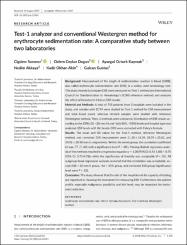Test-1 analyzer and conventional Westergren method for erythrocyte sedimentation rate: A comparative study between two laboratories
| dc.contributor.author | Sönmez, C. | |
| dc.contributor.author | Doğan, O. C. | |
| dc.contributor.author | Kaymak, A. O. | |
| dc.contributor.author | Akkaya, N. | |
| dc.contributor.author | Akın, K. O. | |
| dc.contributor.author | Güntaş, Gülcan | |
| dc.date.accessioned | 2021-12-12T16:56:43Z | |
| dc.date.available | 2021-12-12T16:56:43Z | |
| dc.date.issued | 2018 | |
| dc.identifier.issn | 0887-8013 | |
| dc.identifier.uri | https://doi.org/10.1002/jcla.22384 | |
| dc.identifier.uri | https://hdl.handle.net/20.500.11857/2691 | |
| dc.description.abstract | Background: Measurement of the length of sedimentation reaction in blood (LSRB), also called erythrocyte sedimentation rate (ESR), is a widely used hematology test. This study intends to compare ESR levels measured by Test-1 method and International Council for Standardization in Hematology's (ICSH) reference method, and analyzes the effect of hematocrit (Hct) on ESR results. Material and Methods: A total of 755 patients from 2 hospitals were included in the study, and samples with EDTA were studied by Test-1 method for ESR measurement and total blood count, whereas citrated samples were studied with reference Westergren method. Then, 2 methods were compared. Distribution of ESR results according to the ESR(?20, >20 mm/h) and Hct(?35%, <35%) levels and hospital type was analyzed. ESR levels with Hct levels<35% were corrected with Fabry's formula. Results: The mean and SD values for the Test-1 method, reference Westergren method, and corrected ESR measurement were 21.30 ± 18.39, 28.59 ± 25.82, and 24.92 ± 20.58 mm/h, respectively. Within the whole group, the correlation coefficient (r) was.77 (.7-.80) with a significance level P <.001. Passing-Bablok regression analysis of the methods resulted in a regression equation y = 1.00 (95% Cl: 0.43-1.88) + 0.75 (95% Cl: 0.70-0.78)x while the significance of linearity was acceptable (P <.01). All subgroup linear regression analyses revealed that the correlation was acceptable, except ESR > 20 mm/h group, Hct < 35% group, and corrected ESR group (significance level were P >.10). Conclusion: The study showed that the role of the hospital and the capacity of testing are important in choosing the instrument for measuring ESR. Furthermore, the patient profile, especially malignancy possibility and Hct level, may be important for instrument selection. © 2018 Wiley Periodicals, Inc. | en_US |
| dc.language.iso | eng | en_US |
| dc.publisher | John Wiley and Sons Inc. | en_US |
| dc.relation.ispartof | Journal of Clinical Laboratory Analysis | en_US |
| dc.identifier.doi | 10.1002/jcla.22384 | |
| dc.rights | info:eu-repo/semantics/openAccess | en_US |
| dc.subject | erythrocyte sedimentation rate | en_US |
| dc.subject | Fabry's formula | en_US |
| dc.subject | hematocrit | en_US |
| dc.subject | Test-1 method | en_US |
| dc.subject | Westergren method | en_US |
| dc.title | Test-1 analyzer and conventional Westergren method for erythrocyte sedimentation rate: A comparative study between two laboratories | en_US |
| dc.type | article | |
| dc.department | Fakülteler, Tıp Fakültesi, Temel Tıp Bilimleri, Tıbbi Biyokimya Ana Bilim Dalı Ana Bilim Dalı | |
| dc.identifier.volume | 32 | en_US |
| dc.identifier.issue | 5 | en_US |
| dc.relation.publicationcategory | Makale - Uluslararası Hakemli Dergi - Kurum Öğretim Elemanı | en_US |
| dc.authorscopusid | 56627476800 | |
| dc.authorscopusid | 57215009812 | |
| dc.authorscopusid | 24464123500 | |
| dc.authorscopusid | 56252569400 | |
| dc.authorscopusid | 25630137900 | |
| dc.authorscopusid | 55366092800 | |
| dc.identifier.scopus | 2-s2.0-85040714152 | en_US |
| dc.identifier.pmid | PubMed: 29341286 | en_US |
Bu öğenin dosyaları:
Bu öğe aşağıdaki koleksiyon(lar)da görünmektedir.
-
Makale Koleksiyonu [47]
-
PubMed İndeksli Yayın Koleksiyonu [170]
PubMed Indexed Publications Collection -
Scopus İndeksli Yayınlar Koleksiyonu [951]
Scopus Indexed Publications Collection



















